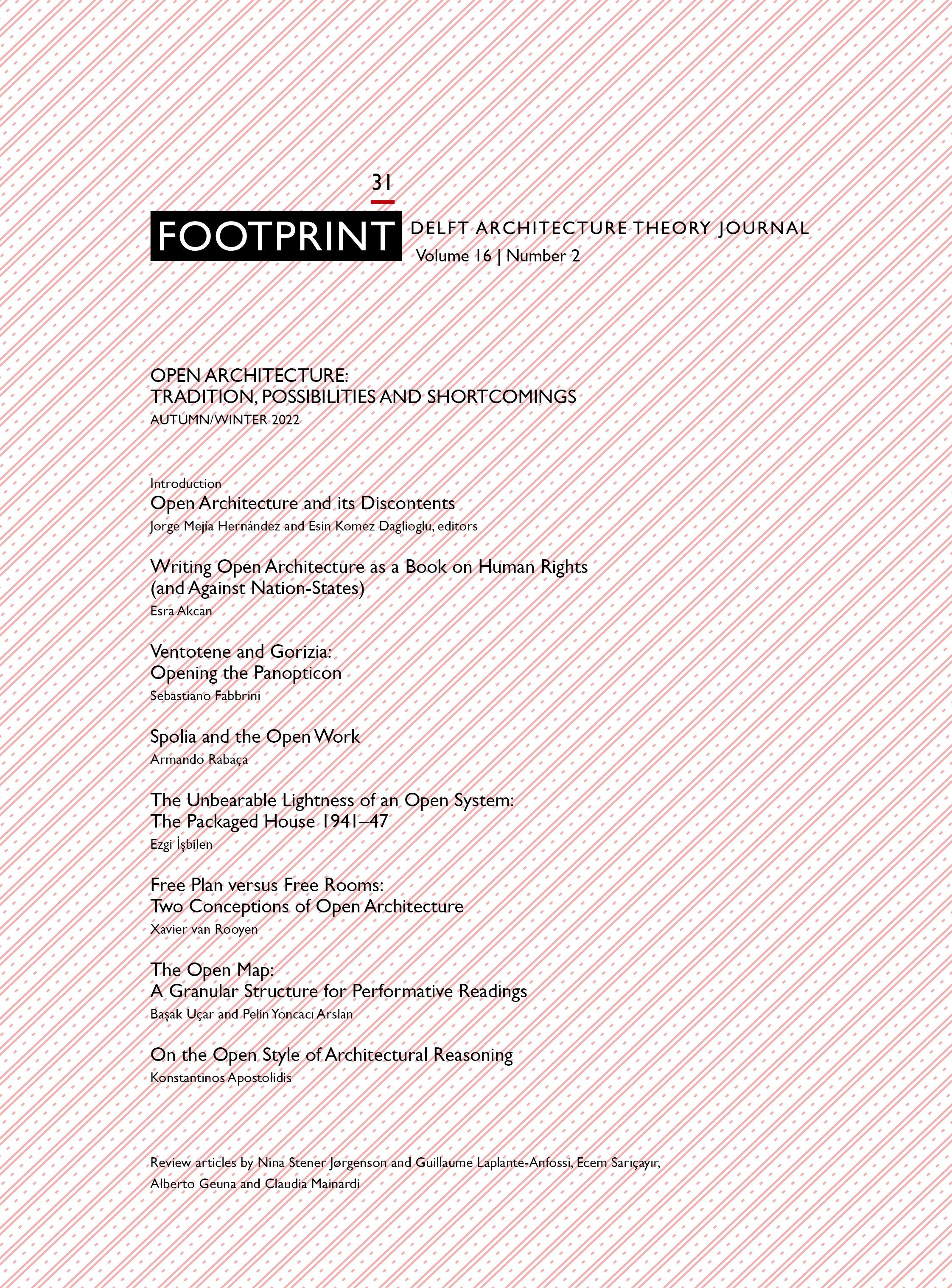The Unbearable Lightness of an Open System
The Packaged House 1941–47
DOI:
https://doi.org/10.7480/footprint.16.2.6089Abstract
One of the many ways in which architecture is conceptually opened up is by adopting systems theory in building technology. In this context, open systems denote modular design and construction; a system of standardized, mass-produced parts that can be configured in various ways opens a field of possibilities. However, there is a significant gap between the high expectations for the implication of the open systems principle and its results.
This essay explores the potentials and consequences of openness in architecture through a historical case study. The Packaged House project (1941–47), designed by Konrad Wachsmann (1901–1980) and Walter Gropius (1883–1969), is a prefabricated housing system devised to meet the housing shortage in the US during and soon after WWII. It was an open spatial design system, a modular construction system and a commercial enterprise all in one. Although it was cultivated in the most favourable political and economic landscape for prefabricated building systems, the Packaged House failed to be widely reproduced. Drawing from the conflicting histories of the Packaged House, the discursive formation of the post-war dwelling, changing definitions of openness, and varied representations, this essay dissects the fantasies of the open building systems as well as their practical and symbolic features.
References
Andrzejewski, Elizabeth. ‘The Wedge Connector: from Function to Symbol.’ In The Art of Joining: Designing the Universal Connector, Bauhaus Taschenbuch Volume 23. Dessau: Spector Books, 2019.
Arieff, Allison . “How to Play FlatPak” dwell, May 1, 2009. https://www.dwell.com/article/how-to-play-flatpak-dd73f653
Booth, William. “House Proud: High design in a factory-made home? Michelle Kaufmann believes she holds the key”, Smithsonian Magazine, January 2007. https://www.smithsonianmag.com/energy-innovators/house-proud-142552310/?page=1
Buckley, Craig. Graphic Assembly: montage, media and experimental architecture in the 1960s. Minneapolis: University of Minnesota Press, 2019.
Carbone, Carlo. ‘The Kit of Parts as Medium and Message for Developing Post-war Dwellings.’ Histories of Postwar Architecture 2(4): 54–74. https://doi.org/10.6092/issn.2611-0075/9648
Cohen, Jean-Louis. Architecture in Uniform: Designing and Building for the Second World War. Montréal: CCA, 2011.
Creighton, Thomas H (ed.). Building for Modern Man . Princeton, NJ: Princeton University Press, 1949.
Davies, Colin. The Prefabricated Home. London: Reaktion Books, 2005.
Deamer, Peggy. Architecture and Labor. New York: Routledge, 2020.
Entenza, John. ‘The Case Study House Program.’ Arts & Architecture, (January 1945):37-39.
Epstein Jones, Dora. ‘Architecture on the Move: Modernity and Mobility in the Postwar.’ PhD diss., UCLA, 2004.
Fisher, Mathew W. ‘Prefabrication and the Postwar House: The California Manifesto.’ In The Value of Design: Design is at the Core of What We Teach and Practice, edited by Phoebe Crisman and Mark Gillem, 403. Washington D.C.: ACSA Press, 2009.
Giedion Sigfried. Walter Gropius: Work and Teamwork. New York: Reinhold publishing, 1954.
Harari, Yuval Noah. Sapiens: A Brief History of Humankind. London: Vintage, 2011.
Herbert, Gilbert. The Dream of the factory-made house: Walter Gropius and Konrad Wachsmann. Cambridge Mass.: MIT Press, 1984.
Herrey, Herman. " PREFABRICATION SYSTEM FOR ARCHITECTS: Konrad Wachsmann and Walter Gropius produce The Packaged Building System, which enables architects to design as they please, on a modular basis." New Pencil Points, April 24, 1943, pp. 36-47.
Imperiale, Alicia. ‘An American Wartime Dream: The Packaged House System of Konrad Wachsmann and Walter Gropius.’ In Offsite: Theory and Practice of Architectural Production, edited by Ryan E. Smith, John Quale, and Rashida Ng, Proceedings of the 2012 ACSA Fall Conference, Offsite: Theory and Practice of Architectural Production, Philadelphia, September 27-29, 2012, 39-43. Philadelphia: ACSA, 2012.
Jarzombek, Mark. ‘Architecture: A Failed Discipline.’ Archis 19, no. 1 (January 2009): 42-43. Also available online at: http://archis.org/volume/architecture-a-failed-discipline/
Kelly, Burnham. The Prefabrication of Houses: A Study by the Albert Farwell Bemis Foundation of the Prefabrication Industry in the United States. New York: The Technology press of MIT and John Wiley and Sons, 1951.
Kelly, Burnham. Design and the Production of Houses. New York: McGraw - Hill , 1959.
Kendall, Stephen. ‘Notes on ‘Open Systems’ in Building Technology.’ Building and Environment 22, no.2 (1987): 93-100.
Kundera, Milan. The Unbearable Lightness of Being. New York: Harper Perennial Modern Classics, 1999.
Moholy-Nagy, László. Vision in Motion. Third edition. Chicago: Paul Theobald, 1947.
Osayimwese, Itohan. Colonialism and Modern Architecture in Germany. Pittsburg: University of Pittsburg Press, 2017.
‘The New House 194X.’ Architectural Forum (September 1942): 65-152
Wachsmann, Konrad. Turning Point of Building: Structure and Design. New York: Reinhold, 1961.
Wachsmann, Konrad. Konrad Wachsmann: An Autobiography “TIMEBRIDGE” 1901-2001. Chicago: Graham Foundation, 1981.
Wachsmann, Konrad. Building the Wooden House: Technique and Design. Basel: Birkhauser, 1995.
Wachsmann, Konrad and Walter Gropius. ‘‘House’ in Industry.’ Arts & Architecture, (November 1947): 28-37.
Wagner, Kate. ‘People Power: In Architecture and Labor, Peggy Deamer recognizes architects are workers.’ The Architect’s Newspaper. January 11, 2021.
https://www.archpaper.com/2021/01/architecture-and-labor-review/
‘What is a house?’ Arts & Architecture, (July 1944): 21-39.
Downloads
Published
Issue
Section
License
Copyright (c) 2023 Ezgi İşbilen

This work is licensed under a Creative Commons Attribution 4.0 International License.
- Authors retain copyright and grant the journal right of first publication with the work simultaneously licensed under a Creative Commons Attribution License that allows others to share the work with an acknowledgement of the work's authorship and initial publication in this journal.
- Authors are able to enter into separate, additional contractual arrangements for the non-exclusive distribution of the journal's published version of the work (e.g., post it to an institutional repository or publish it in a book), with an acknowledgement of its initial publication in this journal.





